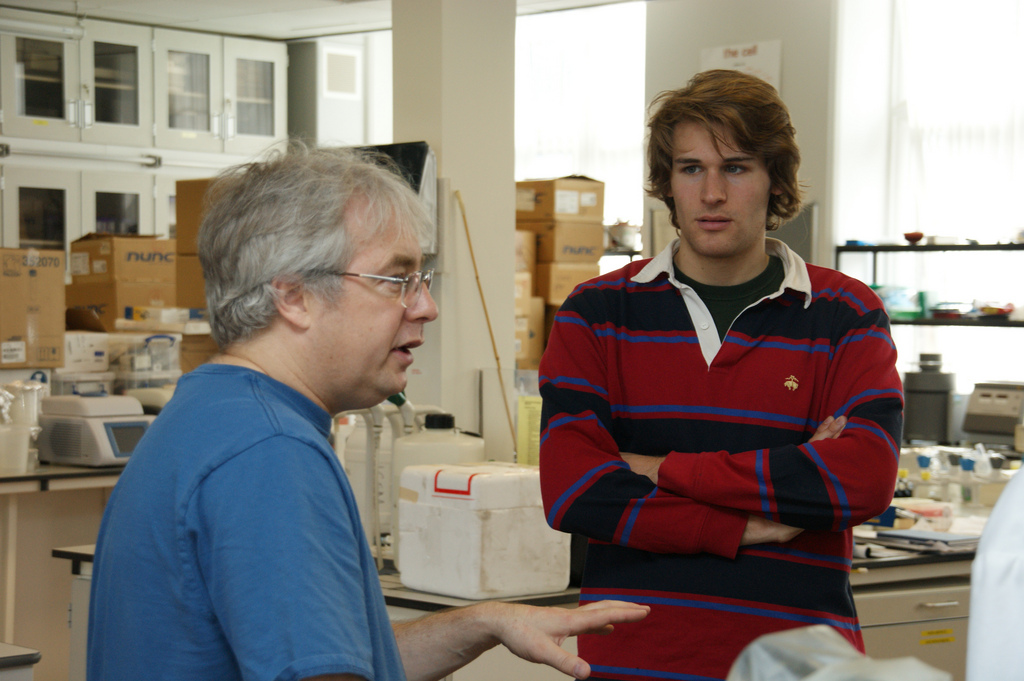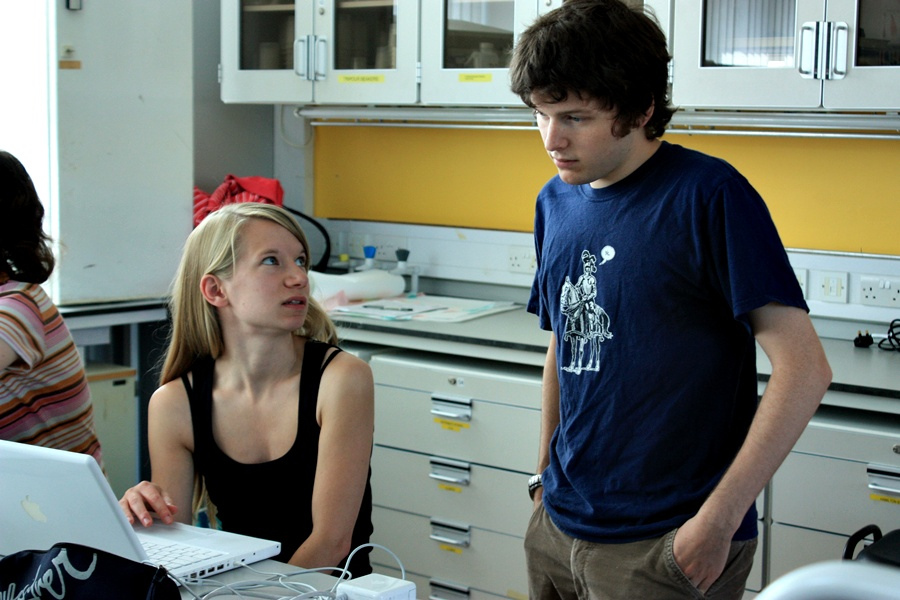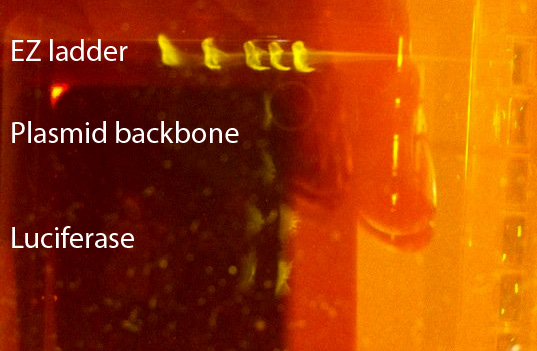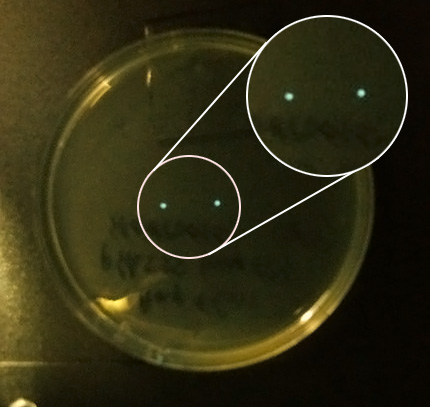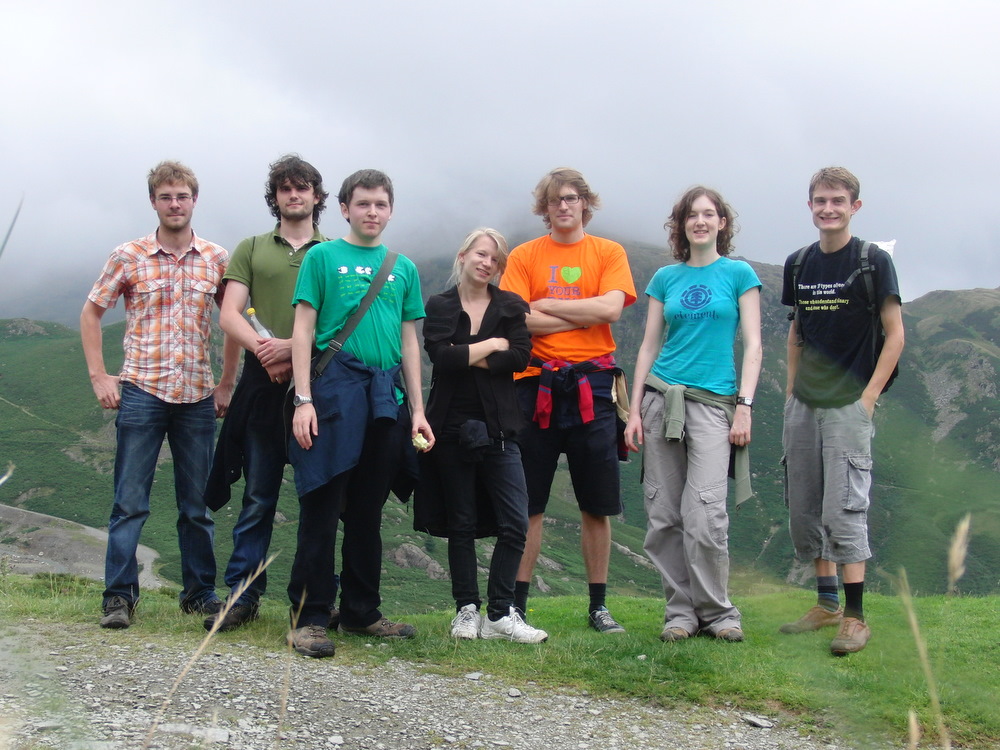Team:Cambridge/Notebook/Week4
From 2010.igem.org
(→Thursday) |
(Replacing page with ' {{:Team:Cambridge/Templates/HybridBook|num=4}}') |
||
| (30 intermediate revisions not shown) | |||
| Line 1: | Line 1: | ||
| - | |||
| - | |||
| - | + | {{:Team:Cambridge/Templates/HybridBook|num=4}} | |
| - | + | ||
| - | + | ||
| - | + | ||
| - | + | ||
| - | + | ||
| - | + | ||
| - | + | ||
| - | + | ||
| - | + | ||
| - | + | ||
| - | + | ||
| - | + | ||
| - | + | ||
| - | + | ||
| - | + | ||
| - | + | ||
| - | + | ||
| - | + | ||
| - | + | ||
| - | + | ||
| - | + | ||
| - | + | ||
| - | + | ||
| - | + | ||
| - | + | ||
| - | + | ||
| - | + | ||
| - | + | ||
| - | + | ||
| - | + | ||
| - | + | ||
| - | + | ||
| - | + | ||
| - | + | ||
| - | + | ||
| - | + | ||
| - | + | ||
| - | + | ||
| - | + | ||
| - | {{:Team:Cambridge/Templates/ | + | |
Latest revision as of 22:43, 18 August 2010

Viewing project diary
View protocols and data
|
Week 4: Monday 2nd - Sunday 8th August
MondayWe transformed some of the competent TOP10 cells we made the previous week with plasmid phK724, which was kindly sent to us by [http://departments.kings.edu/biology/lux/ Jim Slock] We also placed E. coli containing phK555 in 5ml LB broth in a rotating 37°C incubator to grow up overnight. In terms of dry work, we discussed what we wanted to have synthesised. We decided to dismiss PPDK (Pyruvate Orthophosphate Dikinase) and to include the Japanese firefly (Luciola cruciata) because of the ease with which we could change the colour of its emission. TuesdayWe made cells from 4 different hns mutants: W3110 hns93-1, BW25113 Δhns::kan, W3110 hns-205::Tn10, GM230 hns-205::Tn10. This was prompted by a paper suggesting increased bioluminescence in strains with reduced hns. These cells were stored at -80°C for later use We continued to discuss synthesis requirements WednesdayHannah and Theo tested the previous day's preparations for competence. Unfortunately they plated out only 20ul, not enough to get sufficient colonies for an accurate perception of competence. Meanwhile, Peter and Paul transformed E.coli containing phK555 with phK724 and placed the cells in a 30C incubator. (V. fischeri lux proteins denature above this temperature) Bill, Emily, Anja tried to add a prokaryotic RBS and promoter to the firefly luciferase already in the registry. They performed miniprep and restriction digest then ligation, but used incorrect restriction enzymes, such that we could not exclude religated plasmid backbones. ThursdayResultsGM230 hns-205 ::Tn10 TetR (black) - somewhat competent W3110 hns 93-1 (blue) - no transformants BW25113 Δ hns ::kan (red) - somewhat W3110 hns-205::Tn10 TetR - no tansformants Theo's plan
What happened
FridayLigation appeared to have failed. Jim A suggests that we heat to 65 degrees to melt short DNAs after restriction digest, plus that we clean up the DNA with a spin column without gel. PM
SaturdayWe spent the day in the Lake District, a beautiful part of the UK 250 miles North of Cambridge. SundayWent in to the lab on return: Found that:
Theo and Peter:
|
Monday7. Experiment: Transformation of TOP10 cc (Ben, Emily, Bill, Hannah, Will & Anja)Top10 cc taken out of -80°C freezer and tawed on ice. 1ml pipette tip cut with scissors sterilised with ethanol and flamed. Using cut pipette tip ~50μl of TOP10cc were transferred to 1.5ml Eppendorf tubes (3x)
Ce]]s were held on ice for 30min. Heat shocked for 60s at 42°C (waterbath). As a control TOP10cc that had not been transformed with anything (no plasmid DNA added) were subjected to same treatment (as cells to be transformed). Put on ice for ~2min. Added 250μl pre-wardmed (in 37°C) SOC. Incubated at 37°C for Ph with rotation (Eppendorf tubes---> 12ml falcon tubes, tape over top). Plated 50micorl on pre-warmed (in 37°C incubator) LB agar plates with Amp (with blue L-shaped spreader). Grow colonies overnight at 37°2. 8.Experiment: Set up overnight culture of E.coli/pHK555 (Will & Anja)Inoculated single bacterial colony (E.coli/pHK555) in 5ml LB in a 12ml falcon tube. Incubated at 37°C with rotation overnight. (Since it was difficult to see the colony sent from Jim Slock, we picked twice from where we anticipated colony to be and set up 2x5ml LB overnight cultures) 9.Experiment: Set up overnight cultures of W3110 hns 93-1, BW25113 Δhns::kan, W3110 hns-205::Tn10 TetR, GM230 hns-205::Tn10 TetR (Ben & Anja)Inoculated single bacterial colonies in 5ml SOB (i.e. 4 different cultures), incubated at RT with shaking overnight. Tuesday10. Experiment: Preparing chemically competent cells (W3110 hns 93-1, BW25113 Δhns::kan,W3110 hns-205::Tn10 TetR, GM230 hns-205::Tn10 TetR (Ben, Will, Paul, Bill, Emily, Hannah & Anja)(followed protocol for 'TOP10 chemically competent cells cells' from OpenWetWare) Inoculated 0.5ml of the 4 bacterial strains (overnight cultures) in 85ml SOB each. Incubated at 37°C with shaking (180rpm). put on at 11:55am Bacterial Strains:
OD600 measurements:
Cooled cells and (newly prepared) CCMB80 Buffer in ice bath for ~20 minutes. (4) was on ice for over an hour. (2) was on ice for ~40 minutes. (3) was on ice for ~40 minutes. 2 x 30-35ml of each of the four 85ml cultures were poured into 50ml falcon tubes. Centrifuged at 3000g at 4°C for 10 min. Discarded supernatant. Resuspended cell pellet in 20ml tube CCMB80 buffer (ice cold). On ice for 20 min. Centrifuged at 3000g at 4°C for 10 min. Discarded supernatant. Resuspended cell pellet in 5ml tube CCMB80 buffer. Incubated on ice for 20 min. Aliquoted 200μl portions into Eppendorf tubes colour-coded according to the above listed colour labels. Stored at -80°C 11. Experiment: Streaking out of bacterial cultures (E. coli/pHK555) (Paul & Anja)On LB agar plates with Chloranphenicol: E. coli/pHK555 (from both overnight cultures) on two individual plates incubated at 37°C overnight. 12. Experiment: Set up overnight cultures (TOP10 with BBa-J13002, TOP10 with BBa_I712019) (Ben & Anja)Results from transformations on 02/08/10
Inoculated single bacterial (TOP10 with BBa-J13002 and TOP10 with BBa_I712019 individually) colony in 5ml LB, incubated at 37°C with shaking (180rpm) overnight Wednesday13. Experiment: Measuring competency (W3110 hns 93-1, BW25113 Δhns::kan, W3110 hns-205::Tn10 TetR, GM230 hns-205::Tn10 TetR) (Theo & Hannah)Followed protocol under 'TOP10 chemically competent cells' from OpenWetware Competent cells from all 4 different strains taken out of -80°C freezer and thawed on ice. 1ml pipette tips cut with scissors dipped in ethanol and flamed. For each strain 50μl of cells were transferred to a separate 1.5ml Eppendorf tube. 1μl pUC19 (standard plasmid) was added to each 50μl of cells. Held on ice for 30 min. Heat shocked at 42°C for 60s (water bath). On ice for ~2min. 250μl SOC was added to each of 4 tubes. Each Eppendorf tube was put in a 12ml falcon with tape over the top and incubated at 37°C for 1h with rotation. 20μl of each of the 4 different transformed strains were plated on LB agar plages with Amp. Colonies were grown overnight at 37°C. 14. Experiment: Making competent and transforming E. coli/pHK555 (Peter & Paul)50μl EZ Comp buffer transferred to Eppendorf tube and placed on ice. Single E. coli/pHK555 colony resuspended in EZ Comp buffer(2x single colony in 50μl EZ each, 1 streak of colonies in another 50μl EZ). Vortex if needed to suspend clumps. 3μl of pHK724 plasmid added to solution, mixed and incubated on ice for 20 min. Heaat shocked at 42°C for 90s (water bath). Incubated at RT for 5 min. 1ml LB added. Eppendorf tubes put in 12ml falcon tubes with tape over top. Incubated at 37°C for 1h with rotation. Plated 100μl on LB agar plates with Cm and Amp. Incubated at 30°C for 48h. 15. Experiment BioBrick Standard Assembly (Emily & Bill, Paul & Anja)Took overnight cultures of
Plasmid DNA Purificationfollowing the "QIAprrep Spin Miniprep Kit using a Microcentrifuge" protocol. Restriction enzyme digestPrepared at RT in the listed order:
It was checked (Nanodrop!) that 2μl of plasmid DNA would not contain more than 1μg of DNA. The reaction mixtures were mixed gently (flick tube) and spun in the microcentrifuge for 15s (13,000 rpm). It was then incubated at 37°C (water bath) for 30 min. Gel ElectrophoresisAn E-gel EX Agarose 1% was mounted on the transilluminator. Nanodrop readings were taken for both restriction enzyme digests:
For each digest the following mixture was made up
Gel was loaded according to the scheme below:
Empty wells were filled with 20μl deionised H2O. Gel was run and DNA gragments of appropriate sizes were observed:
The plasmid with promoter + rbs as well as te firefly luciferase bands were cut out of the gel (gel cut pipette tips) and DNA was extracted separately from the two gel pieces by following the QIAquick Gel Extraction Kit protocol. LigationFermentas 5X Rapid ligation buffer was taken out of -20°C fridge, thawed and mixed thoroughly prior to use. Nanodrop measurements of the linearised vector DNA as well as the insert DNA were taken:
10-100ng of linearised vector DNA should be added to the ligation mix=>1μl. 3:1 molar exess of insert DNA should be added to the ligation mix. (56.8ng.2153b) * 1653b * 3 = 131ng => 4.5μl Added to a mirocentrifuge tube:
The mix was vortexed and spun for 15s in the microcentrifuge (13,000 rpm). It was incubated at 22°C (RT) for 30 min and stored at 4°C. 16. Experiment: Set up new overnight cultures (TOP10 with BBa_J13002, TOP10 with Ba_I712019) (Peter & Anja)Thursday17. Experiment: Measuring competency (W3110 hns 93-1, BW25113 Δhns: kan, W3110 hns-205::Tn10 TetR, GB 230 hns-205::Tn10 TetR) (Theo & Peter)After 24h the pUC19 transfmration from 04/08/10 had yielded:
pUC19 transformations were repeated following the protocl outlined on 03/08/10, with the exeption that not 20μl but 100μl of the transfomrd strains were plated on LB agar plates with Amp. As a control 100μl of the transformed strains were plated on LB agar plates without anti-biotics. 18. Experiment: Standard BioBrick Assembly (Emily, Bill & Anja)Took oversight cultures of:
Plasmid DNA purificationfollowing the "QIAprep Spin Miniprep Kit using a Microcentrifuge" protocol Restriction enzyme digestPrepared at RT in the listed order:
It was checked (Nanodrop!) that 2μl of plasmid DNA would not contain more than 1μg of DNA. The reaction was mixed gentlyy, spun down and incubated at 37°C for 30 min Gel electrophoresisE-gel EX Agarose 1% was mounted on the transilluminator. Nanodrop readings were taken for both reaction enzyme digests
Prepared following mixture for both digests
Gel was loaded according to the scheme below:
Empty wells were filled with 20μl deionised H2O. Gel was run and DNA bands of length corresponding to plasmid with promoter + rbs (2153b) as well as firefly luciferase (16553b) were cut out the gel. DNA was extracted separately from the two gel pieces by following the QIAquick Gel Extraction Kit Protocol LigationFermentas 5X Rapid ligation buffer was taken out the -20°C freezer, thawed on ice and mixed thoroughly. Nanodrop measurements
10-100ng of linearised vector DNA should be used in ligation mix => 10μl (20ng). 3:1 molar excess of insert DNA should be added to ligation mix. (20ng/2153b) * 1653b * 3 = 46ng => 15μl (46.5ng) Added to a microcentrifuge tube:
Vortexed, spun briefly and incubated at 22°C (RT) fr 30 min TransformationTOP10 cc taken out of -80°C freezer and thawed on ice, 1ml pipette tip cut with scissors sterilised with ethanol and flamed. 50μl of TOP10cc were transferred to 1.5ml Eppendorf tube. 2μl of ligation reaction were added. Cells were held on ice for 30 min. Heat shocked for 60s at 42°C (water bath). Put on ice for ~2min. Added 250μl SOC. Incubated at 37°C for 1h with rotation. Plated 100μl on LB agar plates with Amp. Incubated overnight at 37°C.
19. Experiment: Set up overnight cultures (E. coli/pHK555 transformed with pHK724) (Theo & Anja)2 cyan-glowing colonies of E. coli/pHK555 transformed with pHK724 had grown. One of these was inoculated in 5ml LB and incubated at 30°C overnight. 20. Experiment: Isolation of pHK555 and pHK724 and transformation of TOP10, BW25113 Δhns::kan and GM230 hns-205::Tn10 TetR (Hannah & Will)Took an E. coli/pHK555 and a TOP10/pHK724 colony and separately purified plasmids following the "QIAprep Spin Miniprep Kit using a Microcentrifuge" protocol. Nanodrop measurements. TOP10, BW25113 Δhns::kan and GM230 hns-205::Tn10 TetR cells were transformed with both plasmids together and separately. Control cells were left untransformed. Transformation was performed according to the protocol in experiment 18 (instead of ligation reaction, pHK555 (6μl) and pHK724 (7μl) were added to the commp cells. TOP10 cc transformed with both plasmids got 5μl of pHK724 only). Transformed cells were plated on different antibiotic-containing plates as listed in the table below:
21. Experiment: Set up overnight cultures (E. coli/pHK555 and TOP10/pHK724) (Hannah & Will)Friday22. Results: Measuring competency (W3110 hns 93-1, BW25113 Δhns::kan, W3110 hns-205::Tn10 TetR, GM230 hns-205::Tn10 TetRAfter 24h the pUC19 transformation from Thursday had yielded:
Control: All cells grew fine on LB agar plates without antiiotic. 23. Results: Transformation of ligated promoter + rbs and luciferaseAfter 24h no colonies weree observed on the LB agar + Amp plate. 24. Results: Overnight culture of glowing E. coli/pHK555 transformed with pHK724The culture glowed (cyan) in the dark. 25. Results: Transformation of TOP10, BW25113 Δhns::kan and GM230 hns-205::Tn10 TetR with pHK555 and pHK724
No bacteria from any of the three strains took up both plasmids simultaneously, although when both the plasmids were added to a strain simultaneously there was growth on both of the individual resistance plates – i.e. some bacteria had taken up one and some the other but the probability that any would take up both was so low that no colonies were observed on the ChlAmp plate. No bacteria strains were killed by the heat shocking as smears of bacteria were seen on every plate without antibiotics added that also had a transformed strain plated. The takeup of plasmid 7 was successful in Invitrogen Top 10 strain and in the Red Strain. In the Black strain, the results from the Black strain are less clear – when we added both plasmids there was no colony growth on the Ampicillin plate (plasmid 7 indicates ampicillin resistance) therefore no plasmid 7 was taken up, however we observed growth on the plate which had been transformed by only plasmid 7 then added to an Amp plate. The colony size was extremely variable though, and although there was no colour differences visible we hypothesise that it may have been contaminated during the procedure. 26. Experiment: Streaking out of E. coli/pHK555 trasnformed with pHK724 (Paul, Emily & Anja)Streaked out on a LB agar plate with Cm and Amp Used to write out 2x 'Cambridge', 'Sterilin' & 'iGEM 2010' on LB agar plates with Amp. 27. Experiment: of plasmids pHK724 & pHK555 from TOP10 & SLOCK 10 cells respectively (Will & Emily)Followed "QIAprep Spin Miniprep Kit" protocl from QIAGEN 4 ml of overnight cultures from each (prepared by Will & Hanah) of TOP10/pHK724 and E. coli/pHK555 were used to extract plasmids. Results50μl of sultion was obtained, 1μl of which was used to NanoDrop
plasmids were stored at 4°C 28. Experiment: Making long-term stocks of pHK555 (in Slock10) & pHK724 (in TOP10) (Peter & Emily)Preparation of 40% glycerol solution
For pHK555 & pHK724, separately:
Stored in -80°C freezer in 'Black-GM230 hns-205' storage box. Vials are labelled with stickers: '7' for pHK724, '5' for pHK555. 29. Experiment: Transformation of TOP10, Red strain and Black strain with plasmid pHK724. They have each already been transformed with plasmid pHK555 (Hannah & Theo)AimWe hope to see each colony glowing, with different brightnesses Protocol
Results
ConclusionOnly TOP10 successful however colonies seen on both of red and black strain plates. Further WorkPlate out red and black strain colonies - possible that they had been left to incubate for too long and glowed then stopped glowing. Sunday30. Experiment: Various
|
 "
"
